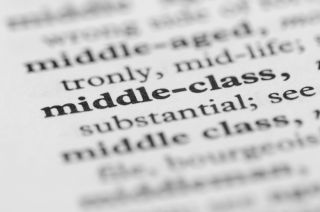Identity
The Psychology of Class
Why do the vast majority of Americans (90%) think that they are middle class?
Updated July 10, 2023 Reviewed by Ray Parker
Key points
- The middle class reflects our national mythology of the “everyman,” an idea central to our national identity.
- Ignoring very real economic and social disparities is woven into the mythology of the American middle class.
- The U.S. Department of Commerce has no definitive guidelines for what constitutes the middle class.

“Searching for the American middle class is a little like looking for air,” historian Loren Baritz wrote in his 1988 The Good Life: The Meaning of Success for the American Middle Class, stating that the group was “everywhere, invisible, and taken for granted.”
The middle class was the heart and soul of the United States, Baritz believed, and a construct that guided individual and collective thought and action. “America’s spirit and tone, its historical mythology and official aspirations, political bent, educational arrangements, the centrality of business enterprise, as well as the dreams of the vast majority of its people, derive from the psychology of the great imperial middle,” Baritz proposed.
Psychology of Class
What is that psychology? A sense of belonging, certainly, and a literal buying into a consumerist lifestyle. Our Constitutional right to pursue happiness is also embedded in the psychological framework of the middle class, as is the idea of social mobility. Conformity, too, is part of its philosophy, along with subscribing to traditional values.
In short, middle-classness is a concept that heavily shapes the self-identity and behavior of most Americans, whether we realize it or not.
The psychological dynamics of the American middle class are grounded in the country’s unique conception of class in general. Class does not really exist in the United States, many of us believe, at least not in the way it exists in other, more hierarchical societies. This (false) belief holds true for many of those who clearly belong to the upper class or lower class, illustrating the populist appeal of being somewhere in the middle.
The difficulty in defining the American middle class reflects this discomfort with the idea of class. Even the U.S. Department of Commerce—an organization intimately familiar with facts and statistics—has concluded that being middle class “is as much a state of mind and aspirations as it is a set of income levels” after conducting a study in 2008. The Department reported that owning a car, having a retirement nest egg, and being able to take a family vacation was as good as any other measure to determine if one is a middle-class American.
Definition of Middle Class
In my own The American Middle Class: A Cultural History, I proposed that the best way to define the middle class is simply by saying that it is those in the economic “middle,” whether measured by income or net worth. (I prefer the latter.) One-third of Americans are thus middle class, I propose, with the remaining thirds being, for lack of better words, upper class, and lower class.
Then why do close to 90 percent of Americans consistently say they are middle class when asked? In a 2015 Pew survey, for example, only 10 percent of Americans said they considered themselves lower class and just 1 percent thought they were upper class. Your doctor likely thinks she or he is middle class, and so does the person who flips burgers at McDonald’s.
National Mythology
The reason that the vast majority of Americans define themselves as middle class is that there are powerful psychic rewards for membership in the group. Because the United States was founded on the principles of democracy and equality, it makes perfect sense that “average” Americans are viewed as most symbolic of what makes this country great and different from others. The middle class reflects our national mythology of the “everyman,” an idea that is central to our national identity.
Conversely, those citizens who are not seen as middle class are often viewed with some suspicion and are considered somehow less “American.” Both the poor and the rich contradict the Constitutional precept that “all men are created equal”; that major class distinctions even exist is seen as a violation of our national creed. The reality is that there always have been great inequalities in wealth and social status in this country, of course, but the endurance of the mythology of classlessness illustrates its profound power.
Despite its actual diversity, the middle class is seen as American as mom, apple pie, and Chevrolet and composed of hard-working, “real” people, who keep the country’s wheels spinning. Hence the continual fretting that the middle class is “shrinking” or “disappearing,” as the "haves" pull ever-further away from the "have-nots."
The irony is that much of the middle class would, if they had the chance, abandon their “averageness” as quickly as possible, in order to realize the paradoxical, very American pursuit of wealth and privilege.
References
Samuel, Lawrence R. (2013). The American Middle Class: A Cultural History. New York: Routledge.




